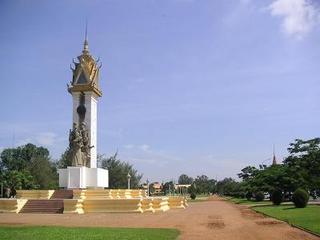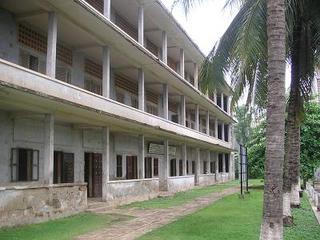
On a cloudy, warm and gently raining day in Phnom Penh (not like the one pictured above), I rode my bike to visit the Khmer Rough prison S-21, now known as the Tuol Sleng Genocide Museum. I keep my bike locked overnight at alot near the local market for a few dollars a month. Yesterday, as I was returning back to the lot on my bike, one of the handlebars broke off. I stayed on the bike, but I was a little suprised to say the least. Many onlookers were prompted to point and laugh at (well, actually with) me and my awkwardly shaped bike as I rode back home. Today I was planning to get the boke fixed somewhere, but when I came to the lot this morning to find my bike, I noticed that someone had welded it back together. When I asked the owners how much I should pay for this mysterious service, they smiled and refused money.

Phnom Penh, with a population of 1.3 million densely packed into a relatively small city radius, is easy to get around by bike. I had passed by S-21 a few times before but never had the chance to go inside. I had also seen the film,"S-21: The Khmer Rouge Killing Machince" when I was in San Francisco, so I was somewhat emotionally prepared to visit. What is perhaps most striking about Tuol Sleng is its ordinariness; the building was actually a high school before it was taken over by the Khmer Rouge.

S-21, or Tuol Sleng, was essentially an interrogation center for the government of Democratic Kampuchea (DK), which exercised an extremely brutal rule over the country from 1975-1979. During the DK years, over 17,000 people, mostly Cambodians, were detained in the prison where they were kept in unbelievely crowded and unsanitary living conditions, were subject to severe beatings, and were frequently tortured to extract (mostly false) confessions of disloyalty to Angkar, the mysterious leadership of DK. Of these 17,00 people who entered Tuol Sleng, less than ten survived.

Now converted into a museum, the compound and its buildings are now filled with displays of pictures of the 17,000 who were interrogated there, both before and after torture. Most of the torture implements remain, and indeed the large bloodstains seen on the floor in photographs of the torture victims can still be seen on the tile floors visitors walk on each day. It's not an easy place to visit, but it is a powerful reminder of the horrrific things we as humans have done to each other throughout history.
No comments:
Post a Comment